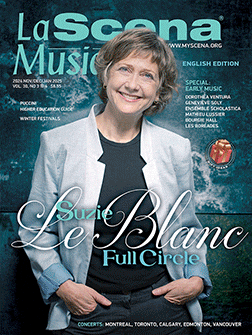
This page is also available in / Cette page est également disponible en:
![]() Francais (French)
Francais (French)
Much the most admired of Beethoven’s 10 Violin Sonatas is the ninth, which we know as the “Kreutzer.” It could just as logically be called the “Bridgetower,” and might have been so, had an unfortunate disagreement not intervened.
George Bridgetower (1778-1860) gave the first performance with the composer at the piano and was probably on track to be the first dedicatee. Our evidence for this is an inscription on the autograph1 by the composer, which can be translated as: “Mulatto sonata composed for the mulatto Bridgetower, great madman and great mulatto composer.”
Despite the apparently humourous tone, Beethoven’s admiration for Bridgetower was genuine. A case can even be made that the unusual heritage of the biracial violinist in part explains the innovative style of the sonata.
In the end, Beethoven chose to dedicate the sonata in its published version to the French violinist Rodolphe Kreutzer (1766-1831), who never played it himself, possibly because he knew it was written originally for another musician. Bridgetower apparently lost his chance at the dedication by making unflattering remarks about a woman who turned out to be Beethoven’s friend.
Bridgetower was born in Poland to a father of African descent, probably born in Barbados, who worked for the Esterházy household; and a European mother, who was also serving in an aristocratic family. The noble circles in which Bridgetower was raised put him in touch with the musicians of the time. He was not the only musician of African descent active in Europe at the time. But while most other Afro-European musicians were kept in the background, Bridgetower overcame the challenges of his race and class to be recognized by his contemporaries. Nor was his importance limited to his association with Beethoven. Josephine R. B. Wright, in an article published in 1980 in The Musical Quarterly, speculated that “a detailed chronicle of his life […] will fill many gaps in our present knowledge of English concert life during the late eighteenth century and will illuminate the role that a black prodigy played in it.”
Bridgetower’s talents were apparent early. Like Mozart around the same period, he was closely supervised by a protective father. By the age of 10, the boy had toured the major European cities, including London. At age 12, because of family issues, he was taken under the protection of the Prince of Wales. The prodigy then had the opportunity to learn from London’s best musicians and quickly became a favourite at the court. His exceptional education partly explains his rise in English society. He was elected to the Royal Society of Musicians in 1807 and obtained a degree in music at Cambridge in 1811.
The “Kreutzer” Sonata, Beethoven’s Op. 47, marks a break in the sonata genre. In 1803, the year of its creation, sonatas and other forms of chamber music were usually performed in salons to please guests. The “Kreutzer,” more than simple entertainment, is a powerful statement. The work is also uncommonly demanding from a technical point of view. As famously reported by Hector Berlioz, even Kreutzer thought that it was “outrageously unintelligible.”
The first movement is of a type that had not been heard before. In his previous eight sonatas for violin and piano, Beethoven had given the piano the principal role, as was the custom for sonatas for piano with accompaniment of a melodic instrument. In Op. 47, the instruments have equal roles, with perhaps a preference given to the violin. And what a task! This highly charged partnership is the core of the sonata. Beethoven specified it in the score: “Quasi come d’un concerto.” In fact, the instruments seem to be engaged in a magnificent battle.
The hurry and exhilaration in which Beethoven found himself in 1803 undoubtedly influenced the work’s character. The composer did not finish the score on time, and Bridgetower had to delay his concert debut by two days. The sonata was finally premiered at noon on May 24. Early that morning Beethoven asked Ferdinand Ries to make a copy of the violin part from the manuscript. Bridgetower had to sight-read the first movement from a last-minute copy of the violin part and played the second movement directly from the score looking over Beethoven’s shoulder.
The first movement especially appears to be a passionate gesture, an impulsive, uncensored glimpse of Beethoven’s mindset. The confusion and intensity expressed in the sonata may well correspond to the composer’s feelings toward Bridgetower. It is said that prior to the sonata’s premiere, the two musicians were constantly together. It seems that Bridgetower greatly stimulated Beethoven as a person and artist.
The “Kreutzer” Sonata represents a tangible shift in the history of the accompanied sonata. It brings the genre to a new level. It also appears at the junction of Beethoven’s “early” and “middle” periods and is viewed as the composer’s break from the norms of chamber music. The work is distinctive – almost revolutionary – by virtue of the dramatic nature of the interaction between the instruments and the exceptional technical skills required for its execution. Beethoven was influenced by his friendship with Bridgetower, who possibly played an active role in its composition. Is the equal treatment of the two instruments – the sonata’s most salient feature – a sign of Beethoven’s respect for his friend and a tribute to racial equality? We cannot say. Nevertheless, Beethoven gave us one of the most striking and fascinating pieces in history. This audacious and powerful work made a lasting impression and has inspired generations of artists.
1 Sonata mulattica composta per il mulatto Brischdauer [Bridgetower], gran pazzo e compositore mulattico
This page is also available in / Cette page est également disponible en:
![]() Francais (French)
Francais (French)













